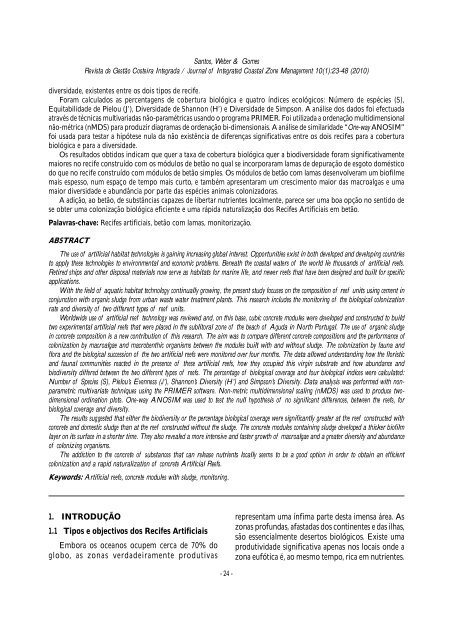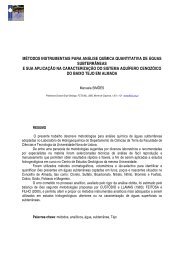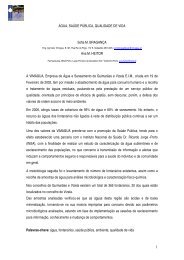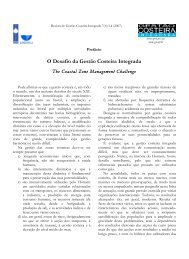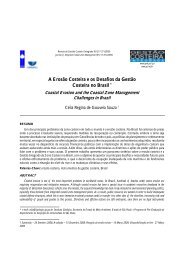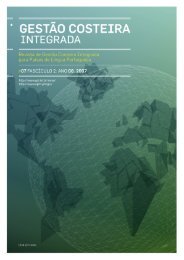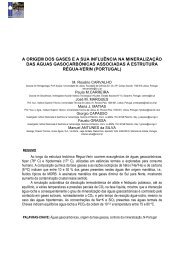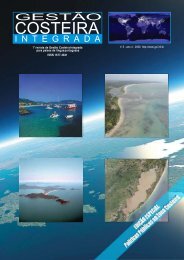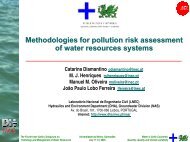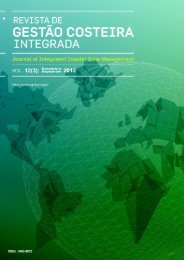Revista integral Full journal - APRH
Revista integral Full journal - APRH
Revista integral Full journal - APRH
You also want an ePaper? Increase the reach of your titles
YUMPU automatically turns print PDFs into web optimized ePapers that Google loves.
Santos, Weber & Gomes<br />
<strong>Revista</strong> de Gestão Costeira Integrada / Journal of Integrated Coastal Zone Management 10(1):23-48 (2010)<br />
diversidade, existentes entre os dois tipos de recife.<br />
Foram calculados as percentagens de cobertura biológica e quatro índices ecológicos: Número de espécies (S),<br />
Equitabilidade de Pielou (J’), Diversidade de Shannon (H’) e Diversidade de Simpson. A análise dos dados foi efectuada<br />
através de técnicas multivariadas não-paramétricas usando o programa PRIMER. Foi utilizada a ordenação multidimensional<br />
não-métrica (nMDS) para produzir diagramas de ordenação bi-dimensionais. A análise de similaridade “One-way ANOSIM”<br />
foi usada para testar a hipótese nula da não existência de diferenças significativas entre os dois recifes para a cobertura<br />
biológica e para a diversidade.<br />
Os resultados obtidos indicam que quer a taxa de cobertura biológica quer a biodiversidade foram significativamente<br />
maiores no recife construído com os módulos de betão no qual se incorporaram lamas de depuração de esgoto doméstico<br />
do que no recife construído com módulos de betão simples. Os módulos de betão com lamas desenvolveram um biofilme<br />
mais espesso, num espaço de tempo mais curto, e também apresentaram um crescimento maior das macroalgas e uma<br />
maior diversidade e abundância por parte das espécies animais colonizadoras.<br />
A adição, ao betão, de substâncias capazes de libertar nutrientes localmente, parece ser uma boa opção no sentido de<br />
se obter uma colonização biológica eficiente e uma rápida naturalização dos Recifes Artificiais em betão.<br />
Palavras-chave: Recifes artificiais, betão com lamas, monitorização.<br />
ABSTRACT<br />
The use of artificial habitat technologies is gaining increasing global interest. Opportunities exist in both developed and developing countries<br />
to apply these technologies to environmental and economic problems. Beneath the coastal waters of the world lie thousands of artificial reefs.<br />
Retired ships and other disposal materials now serve as habitats for marine life, and newer reefs that have been designed and built for specific<br />
applications.<br />
With the field of aquatic habitat technology continually growing, the present study focuses on the composition of reef units using cement in<br />
conjunction with organic sludge from urban waste water treatment plants. This research includes the monitoring of the biological colonization<br />
rate and diversity of two different types of reef units.<br />
Worldwide use of artificial reef technology was reviewed and, on this base, cubic concrete modules were developed and constructed to build<br />
two experimental artificial reefs that were placed in the sublitoral zone of the beach of Aguda in North Portugal. The use of organic sludge<br />
in concrete composition is a new contribution of this research. The aim was to compare different concrete compositions and the performance of<br />
colonization by macroalgae and macrobenthic organisms between the modules built with and without sludge. The colonization by fauna and<br />
flora and the biological succession of the two artificial reefs were monitored over four months. The data allowed understanding how the floristic<br />
and faunal communities reacted in the presence of these artificial reefs, how they occupied this virgin substrate and how abundance and<br />
biodiversity differed between the two different types of reefs. The percentage of biological coverage and four biological indices were calculated:<br />
Number of Species (S), Pielou’s Evenness (J’), Shannon’s Diversity (H’) and Simpson’s Diversity. Data analysis was performed with nonparametric<br />
multivariate techniques using the PRIMER software. Non-metric multidimensional scaling (nMDS) was used to produce twodimensional<br />
ordination plots. One-way ANOSIM was used to test the null hypothesis of no significant differences, between the reefs, for<br />
biological coverage and diversity.<br />
The results suggested that either the biodiversity or the percentage biological coverage were significantly greater at the reef constructed with<br />
concrete and domestic sludge than at the reef constructed without the sludge. The concrete modules containing sludge developed a thicker biofilm<br />
layer on its surface in a shorter time. They also revealed a more intensive and faster growth of macroalgae and a greater diversity and abundance<br />
of colonizing organisms.<br />
The addiction to the concrete of substances that can release nutrients locally seems to be a good option in order to obtain an efficient<br />
colonization and a rapid naturalization of concrete Artificial Reefs.<br />
Keywords: Artificial reefs, concrete modules with sludge, monitoring.<br />
1. INTRODUÇÃO<br />
1.1 Tipos e objectivos dos Recifes Artificiais<br />
Embora os oceanos ocupem cerca de 70% do<br />
globo, as zonas verdadeiramente produtivas<br />
- 24 -<br />
representam uma ínfima parte desta imensa área. As<br />
zonas profundas, afastadas dos continentes e das ilhas,<br />
são essencialmente desertos biológicos. Existe uma<br />
produtividade significativa apenas nos locais onde a<br />
zona eufótica é, ao mesmo tempo, rica em nutrientes.


